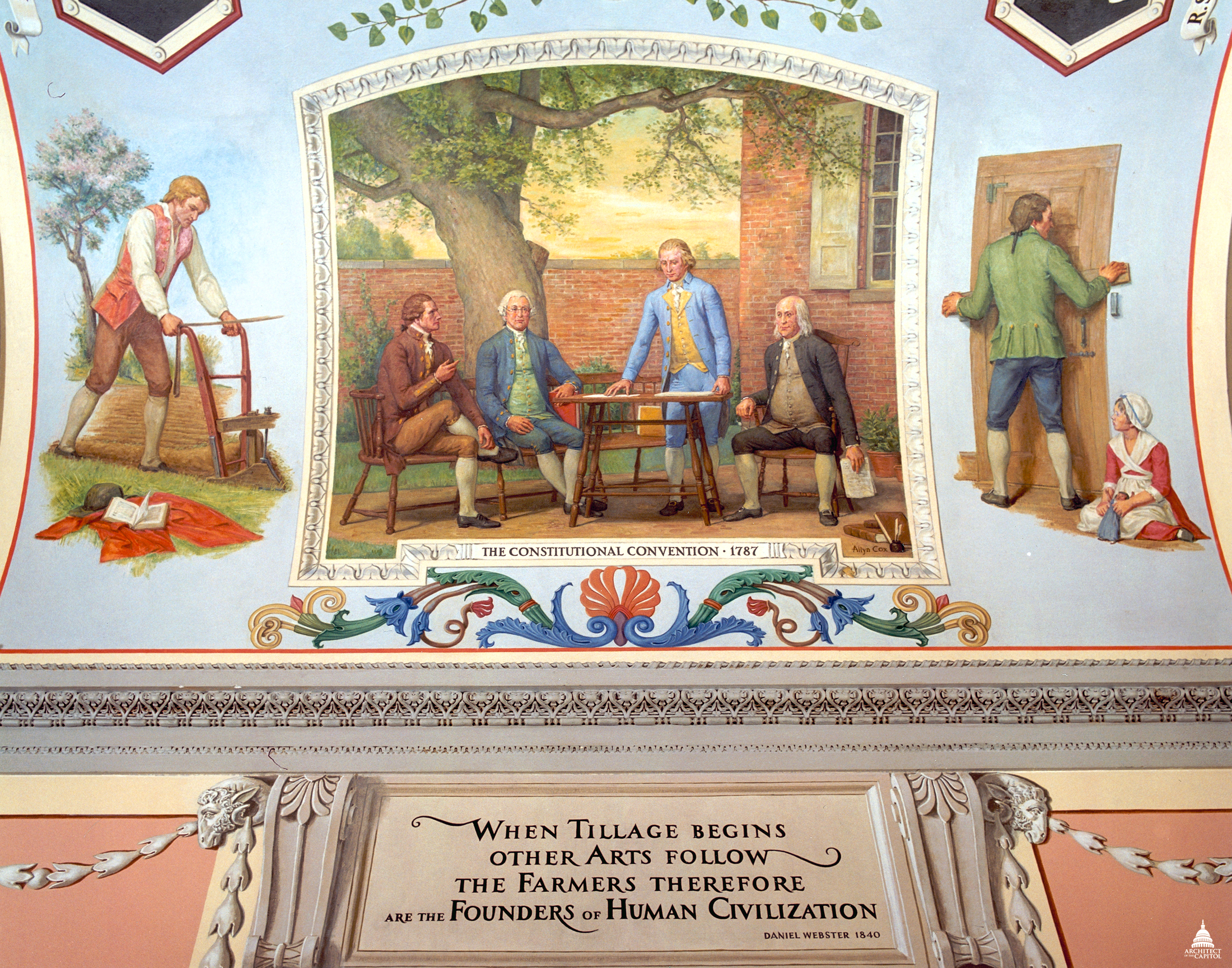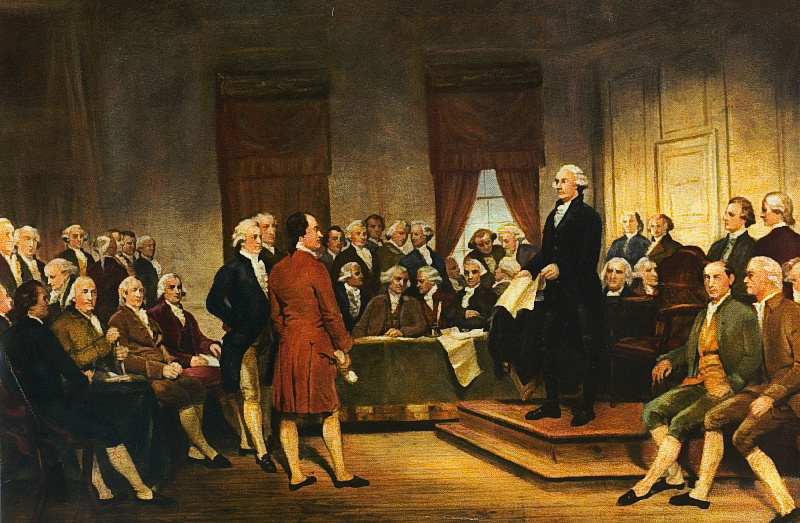Mural of the The Constitutional Convention at the United States Capitol

Topics on the Page
Overview of the Convention
Distribution of Power
Slavery
Rights of States
Rights of Individuals
Native Americans and the Constitution Convention
Women's Rights and the Constitutional Convention
Important Leaders
 CROSS-LINK: Constitutional Convention and the Founders
CROSS-LINK: Constitutional Convention and the Founders
Focus Question: What were the subjects of the major debates at the Constitutional Convention? What patterns emerged in who at the Convention held opposing views?
Overview of the Convention
The Constitutional Convention was a meeting of delegates from 12 of the 13 American states that took place in Philadelphia, Pennsylvania, in 1787. The purpose of the convention was to address the problems with the Articles of Confederation, which had been adopted as the governing document for the United States in 1781. The Articles were proving to be inadequate for governing the country, and the leaders of the time recognized the need for a stronger federal government. During the Constitutional Convention, the delegates debated and discussed various proposals for a new constitution, ultimately producing the United States Constitution. But the process of crafting the document was not a straightforward one, and the framers of the new Constitution had to address countless issues facing the new republic they hoped to establish. Below we will cover many of the major issues they had to confront.

List of The Signers of the Constitution by state.
Click here for a SchoolHouse Rock video about the Preamble to the Constitution.
Follow this link to review the everything that was just covered, including the Articles of Confederation and why it didn't work, how the founders compromised on the constitution, the issue of slavery, federalists and antifederalists, and the process of the ratification of the constitution.
Constitution of the United States: Fast Facts
Washington at the Constitutional Convention. Painting by Junius Brutus Stearns, 1856
Check out this learning game named "Vote With the Delegates" from the Bill of Rights Institute where you can hear arguments from 5 major thought leaders at the Convention on the most pressing issues faced by the delegates. Then you can cast your vote on the path to take forward!
The Assembly Room, Independence Hall


Distribution of Political Power
The delegates from the various states were divided over how political power should be distributed. Two different plans of governmental structure were discussed.
The first plan proposed was the Virginia Plan, which called for a two house legislature (law making bodies), a chief executive (president), and a court system. Our modern government is based in large part on this plan except in regard to legislative representation. The Virginia Plan held that state representation in the legislature should be proportional to its population - this meant states with large populations would have more representation than states with small populations.
Those who didn’t like the Virginia Plans supported the New Jersey Plan. The New Jersey Plan called for a one house legislature where representation would be equal for all of the states. The larger states tended to support the Virginia Plan, while the smaller states supported the New Jersey Plan.
Click here for a learning plan about distribution of power and the Constitutional Convention.
The Great Compromise
Bickering between the various states over representation in the potential government almost ruined the conference. As a result, Benjamin Franklin created a committee to try and resolve conflicts relating to representation. Roger Sherman proposed a compromise between the Virginia and New Jersey Plans. This compromise consisted of having two houses – one based on proportional representation and the other based on equal representation. This comprise paved the way for the way for the United States Congress.
Map of the the number and percent of slaves in each of the 13 colonies in 1770

Slavery
The delegates also fought over whether slaves should be counted as part of the population when determining representation in Congress and the continuing legality of the importation of African slaves.
- The southern states (where slaves made up a significant portion of the population) wanted them to count solely because it would give them more representation in Congress.
- The northern states thought it was absurd that slaves would be counted since legally they were considered property, not citizens. Of course, no one considered making African-Americans full-fledged citizens.
- The second aspect of the “Great Compromise” was to address this debate over whether or not slaves should be counted for determining representation.
- The committee decided on what is called the Three-Fifths compromise: slaves would be counted as three-fifths of a person for the purposes of determining representation and taxes.
In addition to the Three-Fifths compromise, there was also the question of the slave trade itself. The Slave Trade Clause of the US Constitution was a provision in Article I, Section 9 of the original Constitution that allowed the continuation of the African slave trade for a period of 20 years from the date of its ratification. Specifically, the clause stated that "The Migration or Importation of such Persons as any of the States now existing shall think proper to admit, shall not be prohibited by the Congress prior to the Year one thousand eight hundred and eight."
For more on the Slave Trade Clause, check out this analysis from the National Constitution Center.
For more, see The Slavery Compromises
Slavery, the Constitution and a Lasting Legacy, from James Madison's Montpelier website
Slavery FAQs--Property, from Thomas Jefferson's Monticello website
 1790 Census and Apportionment--Analyzing the Three-Fifiths Compromise from the Statistics in Schools from U.S. Census
1790 Census and Apportionment--Analyzing the Three-Fifiths Compromise from the Statistics in Schools from U.S. Census
Rights of States
After the Constitutional Convention a great debate took place over whether or not the states should ratify the document that had been produced. Some Americans in this era were concerned about adopting the constitution because it would create a strong federal government and decrease the power of the various states. Individuals who opposed the adoption of the Constitution – for example, Patrick Henry - are known as Anti-Federalists. Those who supported creating a strong national government by adopting the new constitution were the Federalists. George Washington, Benjamin Franklin, James Madison, Alexander Hamilton, and John Jay advocated the Federalist point of view.
Rights of Individuals
Many of the new state constitutions specifically addressed the rights of individuals. However, the Constitutional Convention did not specifically address the rights of individuals. Many of the delegates simply assumed that the carefully crafted system of government they just created would in and of itself protect citizens from government abuses. In 1791, the constitution was be amended to include ten amendments that specifically address the rights of individuals – these amendments are collectively called the Bill of Rights.
Native Americans and the Constitutional Convention
Click this link to see how Native Americans were fit into the constitution and why.
This article provides information on how the Founders at the Constitutional Convention drew from Native American forms of government, especially the Iroquois Confederacy, to create the Constitution.
Women's Rights and the Constitutional Convention
Just as it was decided that slaves and African Americans were virtually cast out as citizens at the Constitutional convention, the right's of women were equally ignored.
Abigail Adams: "Remember the Ladies" to husband John Adams
Did the American Revolution Change the Role of Women in Society? History in Dispute (Vol. 12)
The Constitutional Status of Women in 1787
Bibliography
Ashbrook Center for Public Affairs at Ashland University, (2006). TeachingAmericanHistory.org . Retrieved April 8, 2007, Web site: http://teachingamericanhistory.org/convention/
Steve, Mount (1995). Retrieved April 8, 2007, from USConstitution.net Web site: http://www.usconstitution.net/index.html
Documents from the Continental Congress and the Constitutional Convention. Retrieved April 8, 2007, from The Library of Congress Web site: http://memory.loc.gov/ammem/collections/continental/
Explore the Constitution. Retrieved April 8, 2007, from National Constitution Center Web site: http://www.constitutioncenter.org/explore/Welcome/index.shtml
Constitution of the United States. Retrieved April 8, 2007, from The National Archives Experience Web site: http://www.archives.gov/national-archives-experience/charters/constitution.html
http://commons.wikimedia.org/wiki/File:Slavery_in_the_13_colonies.jpg
Image IDs from left to right
1. Constitutional Convention Wikimedia Commons, "Scene at the Signing of the Constitution of the United States".
2. Slavery in Virginia Wikimedia Commons, "Virginia one hundred years ago 2".
3. Bill of Rights Wikimedia Commons, "Bill of Rights Pg1of1 AC".
4. Benjamin Franklin Wikimedia Commons, "BenFranklinDuplessis".
5. James Madison Wikimedia Commons, "James Madison".
6. Alexander Hamilton Wikimedia Commons, "Alexander Hamilton".
7. George Washington Wikimedia Commons, "George Washington as CIC of the Continental Army bust".
Comments (0)
You don't have permission to comment on this page.